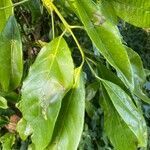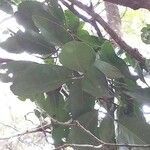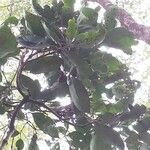Leaves with lamina yellowish-green and dull above, paler green to grey-brown beneath, (5)6·5–14(17) × (2)2·7–8·1(10) cm., elliptic or lanceolate to obovate or oblanceolate, acute or shortly acuminate to obtuse or more rarely rounded at the apex, with margin indurated, glandular-crenulate-denticulate on flowering shoots, shortly appressed-or incurved-spinulose-denticulate on juvenile shoots, cuneate or rarely rounded at the base, coriaceous, with densely reticulate venation prominent beneath but not usually above; petiole 5–13 mm. long.
Cymes in axils of bracts on specialised shoots arising from axils of bracteose prophylls or lowermost foliage leaves on current year’s shoot, forming a paniculate multiflorous inflorescence; peduncle (of cymes) often indistinguishable from “panicle” branches; flowers 1–7(11) in each cyme, 3–5·5 mm. in diam., dioecious.
Shrub or tree (1)4·5–12 m. high (to 30 m. in Uganda); branches 4-lined or not, flattened to quadrangular and pale grey when young, becoming terete and vinous-red to red-brown with prominent whitish lenticels.
Petals 4–5, white or green to pale yellow, 1·5–2 mm. long in female flowers, 2–2·5 mm. long in male flowers, ovate to oblong, often shortly unguiculate, with raised longitudinal ridges, entire.
Female flowers with or rarely without (4)5 petaloid staminodes; disk 4–5-lobed, annular, glabrous; ovary 2–3-locular, ovoid-conic, c. 1/3-immersed in the disk.
Drupe pale yellow, drying dark red or brown, 13–20 mm. long, ellipsoid to subglobose, smooth or with a few emergences.
Sepals 4–5, c. 1 mm. long, semicircular, rounded, entire or very finely serrulate.
Male flowers with 4–5 stamens; disk, slightly 4–5-lobed, flat, glabrous.
Seed 1.




